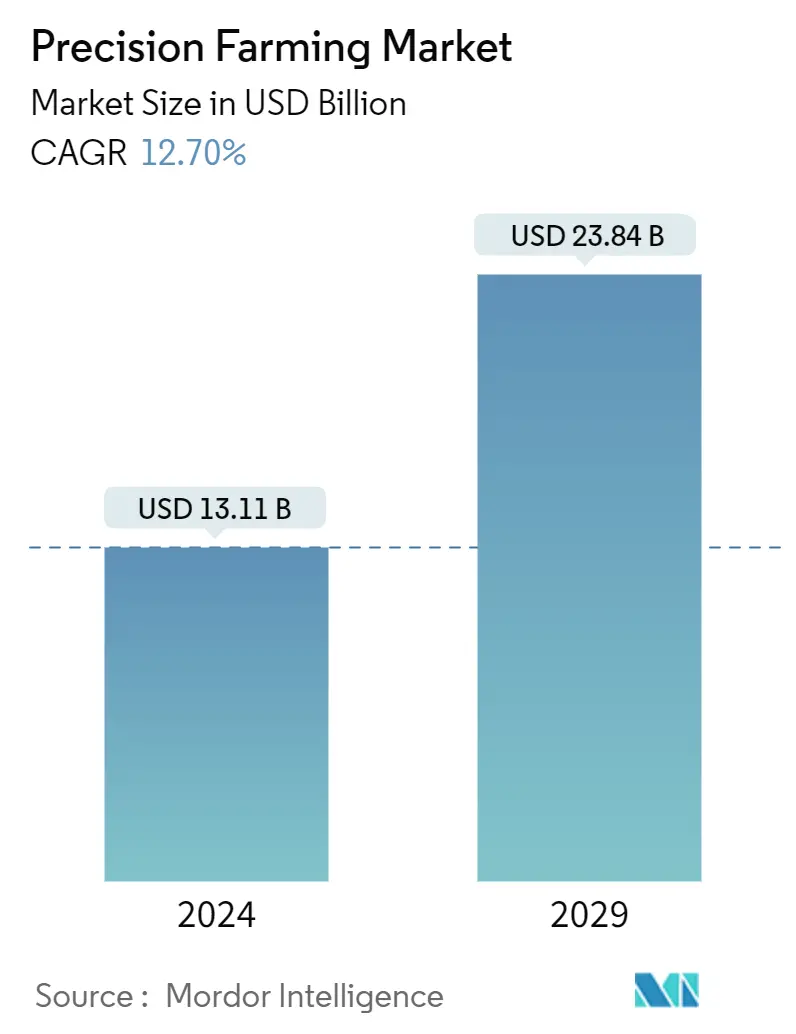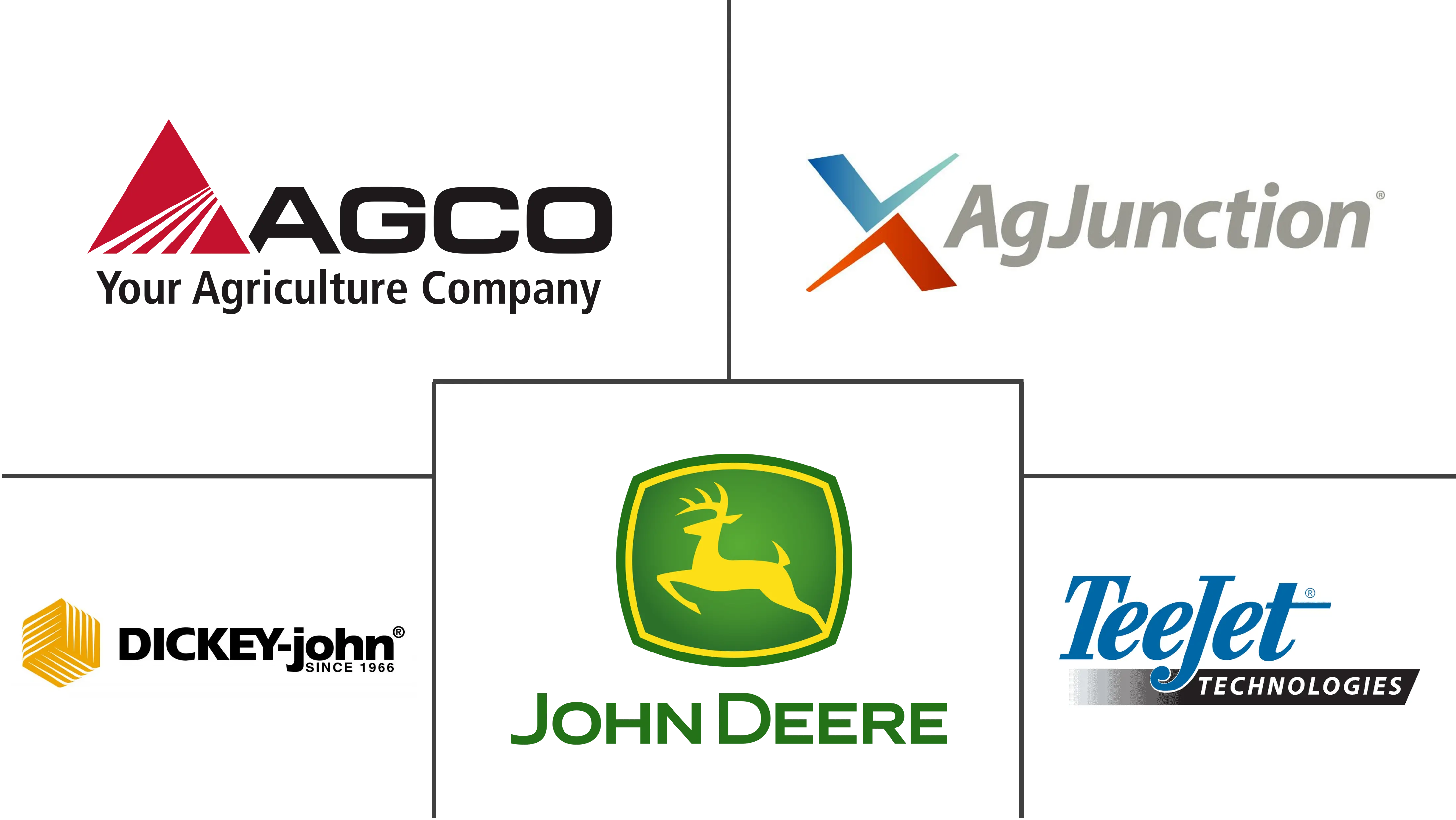Market Size of Precision Farming Industry

| Study Period | 2019 - 2029 |
| Market Size (2024) | USD 13.11 Billion |
| Market Size (2029) | USD 23.84 Billion |
| CAGR (2024 - 2029) | 12.70 % |
| Fastest Growing Market | Asia Pacific |
| Largest Market | North America |
Major Players
*Disclaimer: Major Players sorted in no particular order |
Precision Farming Market Analysis
The Precision Farming Market size is estimated at USD 13.11 billion in 2024, and is expected to reach USD 23.84 billion by 2029, growing at a CAGR of 12.70% during the forecast period (2024-2029).
Some of the main drivers for adopting precision farming are climate change, growing demand for food, more technology adoption in global agriculture sector and government initiatives to improve farmers' efficiency by means of new technologies.
- Precision farming is an agricultural management concept which focuses on the observation, measurement and response to crop variability between fields. Production of plants is focused on the areas defined by property lines, expected crop yields in a given field and geographical and environmental factors.
- Moroever, Precision farming, which will overtake other advances in agriculture by the end of 2030, is predicted to be an important trend. Through the mobile app, real time information on equipment is available through remote sensing and ground communication. (VRTs) has allows farmers to make more specific land management decisions, so that inputs like seeds, fertilisers and pesticides can be used more effectively in the context of changing weather conditions.
- Most broad-market vendors offer guidance systems, climate-weather predictions, and input applications equipment. Small vendors mainly target smart irrigation and field monitoring techniques specializing in IoT solutions. North America is the early adopter of technology and has a significant adoption rate of many innovative technologies used in precision farming. The region is a substantial adopter of IoT, big data, drones, and robotics in agriculture.
- Moreover, growing investments in technologies such as driverless tractors, guidance systems, and GPS sensing systems are also anticipated to contribute to the precision agriculture market scope growth during the study period.
- High costs have made it tough for small-scale farmers to deploy the tools, thereby, restricting them to only large farms. However, variable rate application (VRA) and controlled traffic systems (CTF) help in enhanced utilization of crop nutrients, improvement of crop quality, and the reduction of overlap, thus resulting in better production economy.
- However, more significant adoption could result from deploying remote sensing and farm management software technologies after COVID-19. Businesses have already started concentrating more on wireless platforms to support real-time decision-making for crop health monitoring, yield monitoring, irrigation scheduling, field mapping, and harvesting management. This may propel the studied market demand in the forecasted period.
Precision Farming Industry Segmentation
Precision farming (PF) is the approach of farm management that brings in information technology IT to ensure that the crops and soil get what they need for health and productivity. The goal of PA is to guarantee profitability, sustainability, and protection of the environment. PA is also recognized as satellite agriculture, as-needed farming, and site-specific crop management (SSCM).
The precision agriculture market is segmented by technology (guidance systems, remote sensing, variable-rate technology, drones, and UAVs), component (hardware, software, services), application (yield monitoring, variable rate application, field mapping, soil monitoring, crop scouting), and geography (North America (United States, Canada), Europe (Germany, United Kingdom, France, Rest of Europe), Asia-Pacific (China, Japan, India, Australia, Rest of the Asia-Pacific), Latin America, Middle East & Africa). The market sizes and forecasts are provided in terms of value (USD) for all the above segments.
| By Technology | |||||
| |||||
| Remote Sensing | |||||
| |||||
| Drones and UAVs | |||||
| Other Technologies |
| By Component | |
| Hardware | |
| Software | |
| Services |
| By Application | |
| Yield Monitoring | |
| Variable Rate Application | |
| Field Mapping | |
| Soil Monitoring | |
| Crop Scouting | |
| Other Applications |
| By Geography | |||||||
| |||||||
| |||||||
| |||||||
| Latin America | |||||||
| Middle East & Africa |
Precision Farming Market Size Summary
The precision farming market is poised for significant growth, driven by factors such as climate change, increasing food demand, and the adoption of advanced technologies in agriculture. This agricultural management approach focuses on optimizing crop production by monitoring and responding to variability in fields, leveraging tools like mobile apps, remote sensing, and ground communication. The integration of IoT, big data, drones, and robotics is particularly prominent in North America, which leads in adopting these innovations. Despite high costs limiting access for small-scale farmers, technologies like variable rate application and controlled traffic systems are enhancing crop nutrient utilization and improving production efficiency. The post-COVID-19 era has seen a shift towards wireless platforms for real-time decision-making, further propelling market demand.
In regions like Asia-Pacific, government initiatives are encouraging the adoption of precision farming technologies to boost productivity. The market is characterized by a high degree of fragmentation, with key players such as AgJunction Inc., Raven Industries Inc., and Deere & Co. actively expanding their offerings through strategic collaborations and acquisitions. These companies are focusing on integrating digital tools for sustainability and efficiency in farming practices. The use of drones, UAVs, and advanced soil monitoring sensors is expected to drive market growth, particularly in Australia and other Asian countries, where augmented yield and profitability are key motivators for farmers.
Precision Farming Market Size - Table of Contents
-
1. MARKET INSIGHTS
-
1.1 Market Overview
-
1.2 Industry Attractiveness- Porter's Five Forces Analysis
-
1.2.1 Bargaining Power of Buyers
-
1.2.2 Bargaining Power of Suppliers
-
1.2.3 Threat of New Entrants
-
1.2.4 Threat of Substitute Products
-
1.2.5 Intensity of Competitive Rivalry
-
-
1.3 Assessment Of COVID-19 Impact On The Industry
-
-
2. MARKET SEGMENTATION
-
2.1 By Technology
-
2.1.1 Guidance System
-
2.1.1.1 Global Positioning System (GPS)/ Global Satellite Navigation System (GNSS)
-
2.1.1.2 Global Information System (GIS)
-
-
2.1.2 Remote Sensing
-
2.1.3 Variable-rate Technology
-
2.1.3.1 Variable Rate Fertilizer
-
2.1.3.2 Variable Rate Seeding
-
2.1.3.3 Variable Rate Pesticide
-
-
2.1.4 Drones and UAVs
-
2.1.5 Other Technologies
-
-
2.2 By Component
-
2.2.1 Hardware
-
2.2.2 Software
-
2.2.3 Services
-
-
2.3 By Application
-
2.3.1 Yield Monitoring
-
2.3.2 Variable Rate Application
-
2.3.3 Field Mapping
-
2.3.4 Soil Monitoring
-
2.3.5 Crop Scouting
-
2.3.6 Other Applications
-
-
2.4 By Geography
-
2.4.1 North America
-
2.4.1.1 United States
-
2.4.1.2 Canada
-
-
2.4.2 Europe
-
2.4.2.1 Germany
-
2.4.2.2 United Kingdom
-
2.4.2.3 France
-
2.4.2.4 Rest of Europe
-
-
2.4.3 Asia-Pacific
-
2.4.3.1 China
-
2.4.3.2 Japan
-
2.4.3.3 India
-
2.4.3.4 Australia
-
2.4.3.5 Rest of the Asia-Pacific
-
-
2.4.4 Latin America
-
2.4.5 Middle East & Africa
-
-
Precision Farming Market Size FAQs
How big is the Precision Farming Market?
The Precision Farming Market size is expected to reach USD 13.11 billion in 2024 and grow at a CAGR of 12.70% to reach USD 23.84 billion by 2029.
What is the current Precision Farming Market size?
In 2024, the Precision Farming Market size is expected to reach USD 13.11 billion.

